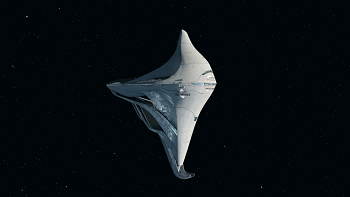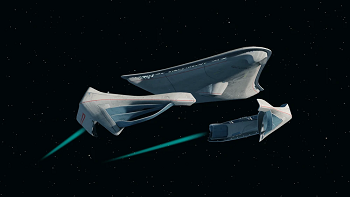Battle Group Omega
Created by Captain Luzol Targaryen on Sun Jan 16th, 2022 @ 5:11pm
Established in response to the Borg crisis in the late 24th Century, Battle Group Omega was created by the Federation Starfleet to serve as a rapid response force to respond to Borg incursions. A roving force, the Battle Group's mission evolved over time as the Federation faced less and less assaults from the Borg to function as a rapid response group to respond to galactic crises. The success of the Battle Group Omega endeavor eventually led to the establishment of additional Battle Groups throughout Starfleet.
Missions
Battle Group Omega has been tasked with accomplishing a variety of missions both in peace and wartime. The peacetime mission is to conduct forward presence operations, to help shape the strategic environment, deter conflict, build interoperability with allies, and respond to crises when necessary. The ships in the group often "disaggregate," performing missions away from the rest of the Battle Group as needed.The missions of Battle Group Omega include:
- Power projection against a wide range of strategic, operational, and tactical targets.
- Establishing space supremacy in an area by seizing and maintaining control of designated airspace.
- Protection of commercial and military shipping.
- Protection of Federation Ground forces prior to or during planetside operations.
- Humanitarian Assistance/Disaster Relief (HA/DR).
- Surveillance/Intelligence to achieve and maintain a comprehensive operational picture of the environment.
- Command and Control of assigned Federation and allied forces.
- Proximity defense and defense of selected theater-wide areas against attack.
- Operations in support of the peacetime presence mission, including supporting Federation diplomacy through cooperative engagement with designated allied forces, normal peacetime operations, and shows of force.
Composition
During its lifetime, Battle Group Omega was never restricted to a specific composition and would be routinely modified depending on expected threats, roles, or missions during a deployment. All Battle Groups all are comprised of similar types of ships and typically includes:
- A
- Two
- Two
- Two
- Two
Command Structure
Battle Group Omega comprises several individual commands, all of which reside under the authority of the Battle Group Commander. While some Battle Groups are typically led by a Flag Officer holding the rank of Commodore, who often promotes to Rear Admiral while on assignment, Battle Group Omega is typically led by a Vice Admiral due to the importance of its mission profile in the grand scheme of its assignment. The Battle Group Commander is the operational commander to all vessels in the Battle Group and is responsible for unit-level training, integrated training, and readiness for assigned ships and units, as well as maintaining administrative functions and material readiness tracking for ships and squadrons assigned to the group.During combat, the Battle Group Commander acts as the central command authority for the entire Battle Group and designates subordinate warfare commanders for various assignments.
Assigned Vessels
Flagship |
|
USS Stargazer - Merian Class |
|
|---|---|
 |
The United Federation of Planets is never going separate itself from its need for starships that are specialized in rescue and relief missions, and the Merian-class was well-known for serving this role with distinction even during the dark times following The Burn. Its specialized systems are focused on being a bulwark against harmful elements, be they enemy vessel, or naturally-occurring stellar phenomena, to provide protection and support for those most in need. |
Cruiser Wing |
|
USS Nostromo - Eisenberg Class |
|
 |
The versatility and ingenuity of Federation starships are dangerous to under-estimate, and that is no exception with the efforts that have gone into the development of the Eisenberg Star Cruiser. With a focus on exploration and scientific discovery, this vessel's design was intended to usher the Federation into a new age of discovery, before the fleet ended up decimated by a catastrophe that left Starfleet scrambling for resources. In the wake of that disaster, it was heroic captains of vessels of this class - such as the U.S.S. Nog - that kept the spark of hope alive. |
Destroyer Wing |
|
USS Chin'toka - Courage Class |
|
 |
Centuries of starship design tradition from races across the Milky Way galaxy have allowed certain aspects of their construction to be matters that are designed by-rote, and rarely questioned or re-examined. Deflector dishes and emitters are mounted in the front, while impulse engines belong in the back, as an example. However, once in a while a group of ship designers decides to be courageous and inventive enough to buck trends, and explore new possibilities. The Courage-class is the culmination of similar exploration, as a starship designed to treat directional bias as a matter of purpose and forethought, rather than an afterthought. This unique vessel is supported by a series of subsystems that allow the ship to transform its capabilities by reversing its direction. In its default configuration, a large secondary deflector and specialized set of sensors and emitters fuel the ship's scientific pursuits. However, by reversing its orientation, the ship's systems are redirected into a bulwark of defensive tactical capabilities that would not be out of place on its battlecruiser peers |
Escort Wing |
|
USS Anesidora - Mars Class |
|
 |
This starship's design was born in pursuit of alternative forms of FTL travel that do not rely upon a Dilithium-based reaction. The ship's sleek and streamlined structure, as well as relatively substantial propulsion subsystems, evolved from attempts to reduce warp bubble footprints, and otherwise facilitate the ship's travel using theoretical subspace propulsion techniques. Although the experiments with subspace manipulation ultimately failed to produce viable travel alternatives, the technology was still deemed suitable for defensive purposes, resulting in the Mars-class Escort project being deemed a qualified success. The vessel has been put into production by Starfleet with these specialized subspace emitters in place, but re-purposed to serve as deterrents against factions that might threaten the Federation. |
Specialty Wing |
|
USS Ghee P'Trell - Saturn Class (Medical) |
|
 |
The distinctive ring-like design of this ship's primary hull was dubbed the Saturn-class by its Sol-based engineers early in its concept phases, in honor of the breathtaking rings found around its namesake planet. The design is more than just esthetic though, as it allows for experimental torus-shaped deflector shields and warp fields. This intriguing shape allows this class of starship to utilize the negative space within the ring to isolate and study dangerous phenomena at close proximity, as well as pioneering more efficient methods of energy manipulation for space flight at both impulse and warp scales. The latter of these breakthroughs proved to be even more valuable to the remnants of the Federation after the event known as The Burn. |
Categories: No categories found